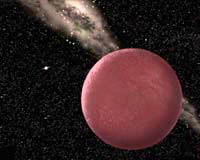"Instead of Pluto being a unique object that's difficult to understand (has frozen methane crust), we now see it as part of a family of objects (Xena, Sedna and Easterbunny that also have frozen methane crusts). We can try to understand the entire family, with Pluto being the middle sized member of the three. That's very exciting to us."
- Michael E. Brown, Astronomer

September 15, 2005 Pasadena, California - A couple of months ago in late July, astronomer Michael Brown and his colleagues at the California Institute of Technology, announced their discovery of "Planet X." It's a big chunk of rock and ice nine billion miles from the sun. It's actually bigger than Pluto - and far beyond Pluto in what is known as the Kuiper Belt that circles our solar system. Now, almost two months later, the International Astronomical Union still has not decided if the exciting discovery should be classified a planet or what it's official name should be.
Click here to subscribe and get instant access to read this report.
Click here to check your existing subscription status.
Existing members, login below:
© 1998 - 2024 by Linda Moulton Howe.
All Rights Reserved.

